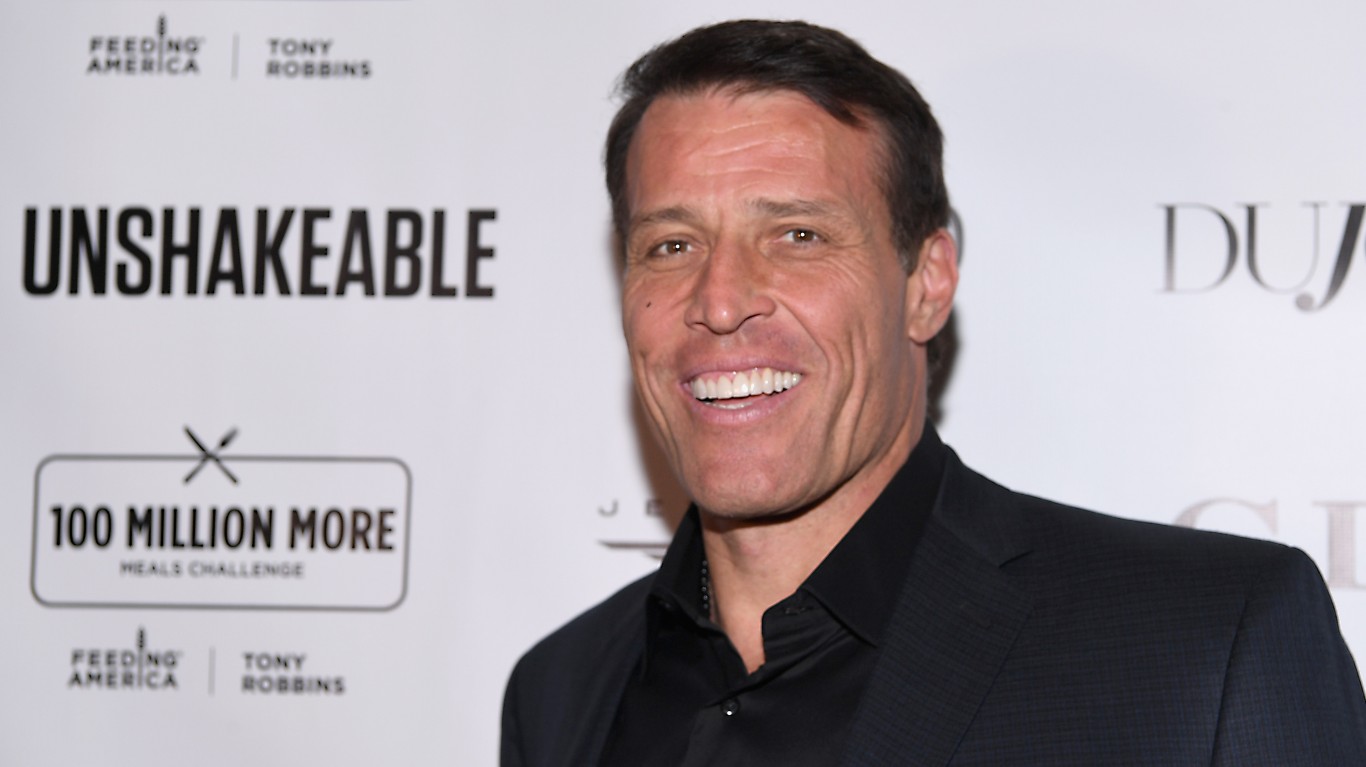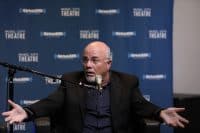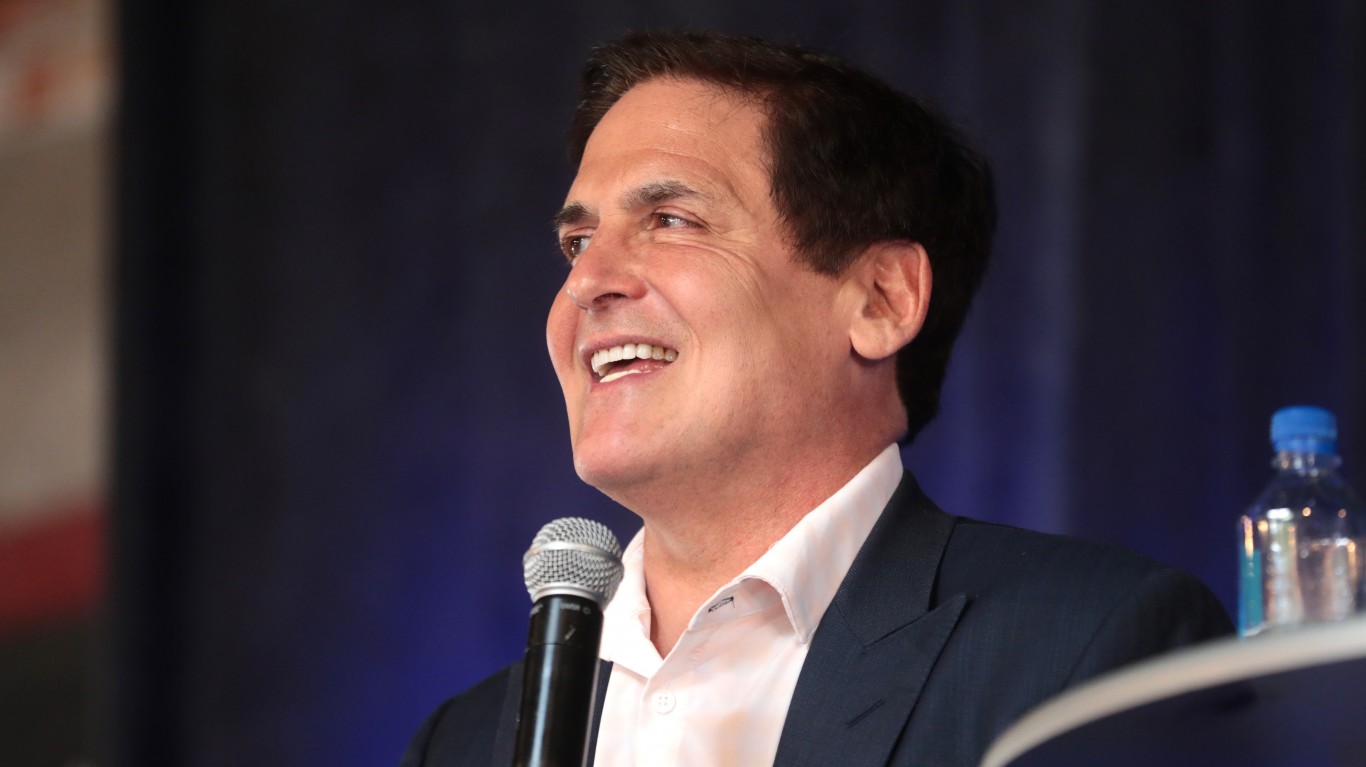
With an estimated $600 million net worth, author, motivational speaker, personal coach and entrepreneur Tony Robbins has built a lucrative career on emulating the practices of successful people. Teaching millions of people how to copy these practices with applicable principles that can apply in a variety of situations, the 6’6” Robbins, who suffered from a pituitary tumor at an early age, has overcome personal obstacles to become the highest-paid motivational speaker in history. His book, Awaken the Giant Within sold 2 million copies, and opened the door for his other best-selling books.
Tony Robbins has authored a number of books about investing and financial management, including the following:
- MONEY Master the Game: & Steps to Financial Freedom
- UNSHAKABLE: Your Financial Freedom Playbook
- THE PATH: Accelerating Your Journey to Financial Freedom
- The Holy Grail of Investing
To his credit, Robbins does extensive research and unhesitatingly gives credit where due to his sources for concepts. The books feature interviews with such financial luminaries as John Bogle, Carl Icahn, Warren Buffett, and others. Robbins’ gift is in establishing easy to remember analogies that illustrate the underlying principles behind many of the successful strategies.
Key Points
-
Motivational speaker, author, and coach Tony Robbins has helped millions of people take control of their careers, finances, and personal lives through following time-tested principles gleaned from his observations of successful people and their practices.
-
Tony Robbins’ books about finance and investing include helpful information that can be boiled down to several tips, such as the ones featured in this article.
-
The analogies that Tony Robbins uses to illustrate his points are well conceived and sufficiently visual to make them easy to recall.
-
The analogies that Tony Robbins uses to illustrate his points are well conceived and sufficiently visual to make them easy to recall.
-
4 million Americans are set to retire this year. If you want to join them, click here now to see if you’re behind, or ahead. It only takes a minute. (Sponsor)
The old maxim, “You can’t teach an old dog new tricks”, alludes to the stubbornness of those who are older, and more set in their ways out of deeply ingrained habits. A large number of Robbins’ advice tips are specifically applicable towards retirees, who often exhibit greater resistance to changing their habits and practices unless they experience a major attitude shift or revelatory concept that resonates with them.
Tony Robbins’ books contain a mix of mindset principles and practical applications. The core principles of his books revolve around principles regarding discipline, reining in emotions when needing to be clear headed about crucial decisions, and modeling habits and practices of successful people in various fields instead of reinventing the wheel.
The Financial Mental Challenge

Tony Robbins’ Financial Advice can be divided between mental tips, which have to do with attitudes and strategies, and practical tips, which address tangible steps to apply the concepts. Some principles from MONEY Master the Game: & Steps to Financial Freedom include such insights as:
- Shift From Consumer to Owner – Robbins believes that an ownership mindset, like that of all successful entrepreneurs, is a key to financial independence. A consumer or operator mindset exchanges their time or money to acquire products. Conversely, an owner creates something of value and comes away owning something a tangible product or service asset with intrinsic worth. By being an investor, this is the first step towards an owner mindset. One example would be the decision to start a retirement plan, if one has none at the moment. By taking that step, it is an ownership triggered decision – in this case, ownership and some control over the direction of one’s own future lifestyle.
- Become An Insider – One of Tony Robbins’ key principles is learning as much as one can about something before deciding to undertake it, rather than go in blindly or relying on sheer luck. When it comes to investing, this involves familiarization with the rules of the game, how it operates, and what recourse is available if there’s a problem. Simply buying a mutual fund or ETF without looking at the annual fees for comparison is one example or failing to become an insider.. “Most danger,” says Tony Robbins, “lies in the fact that what you don’t know can hurt you.” In other words, “failing to prepare is preparing to fail.”
- Developing a Pro-Diversification Mindset – While many investors have done very well with putting all of their assets into VOO or some other S&P 500 Index ETF, that may be good for a F.I.R.E. strategy when one is younger, but diversification is a prudent strategy to take because of the built-in downside mitigation aspects. Additionally, having all of one’s eggs in a single basket can create a lazy approach that causes one to miss out on other opportunities.
- Creating a Lifetime Income Plan – With diversification in mind, Robbins borrows a strategy from billionaire Bridgewater Associates founder Ray Dalio that he calls the All Seasons Strategy as a prime example. Dalio’s approach follows 4 things that move the price of assets: inflation, deflation, rising economic growth, and declining economic growth. Higher than expected growth will trigger higher than expected inflation. Lower than expected growth leads to lower than expected inflation. Dalio defines four economic seasons and that one needs the foresight to invest today for what tomorrow brings by paying attention to the economic indicators that are a part of everyday life. The All Seasons strategy is:
- 30% stocks
- 40% long-term bonds
- 15% intermediate U.S. bonds
- 7.5% commodities
- 7.5% gold
The primary thrust of this step is to create a customized plan to suit individual needs.
- Invest Like the .001% – In his interviews with Buffett, Bogle, and Icahn, Robbins notes that there are some common threads between these investing titans, despite their very disparate approaches. These common notions are ones that Robbins advises, should be modeled and applied to one’s own outlook. They are:
(1) Don’t lose money; (2) Risk a little to make a lot; (3) Anticipate and Diversify, and (4) You’re never done.
Putting Concepts Into Action

Tony Robbins’ success is half due to his ability to tap into and quantify the problems many people encounter and what may be the various emotional or psychological underlying causes. The other half is his clearly identified action strategies for people to address and ameliorate those problems. For investing, he has cited the following topics, potential problems, and how to avoid or fix them:
- Asset Allocation – Citing historical periods of market turbulence, such as the 9-11 World Trade Center Attack, the Dot Com bubble, and the 2008 Subprime Mortgage Banking meltdown, Robbins compares a $100,000 stock portfolio form 2000-2009 would have lost nearly $7,000 by 2009, whereas staying the course with a mix of low cost index funds would have grown to over $191,000 in the same timeframe. Lesson: don’t let emotions and a herd mentality undermine an otherwise sound strategy. Dollar-cost average when the market is down, and put off emotion triggered illogical decisions.
- Capitalize on Compound Interest – Robbins encourages jumping in early to take advantage of compound interest, since it takes several years before the true benefits become manifest. He cites this comparison example:
- Investor #1 begins investing at age 19 and continues contributing $300 per month until age 27. At that point, the money is simply left in the account to compound, with no further contributions made. Assuming the market returns 10% per year, as per its long-term average, the $28,800 this person invested over those 8 years would be worth nearly $2 million by age 65.
- Investor # 2 doesn’t start investing until age 28, but keeps putting away $300 per month until age 65, for a total contribution of $133,200.
- Perhaps surprisingly, Investor # 1, by investing early and letting compounding do its magic, outperformed Investor No. 2, who, even with an additional $104,400 in contributions, ended up with a nest egg of only about $1.4 million, roughly 30% less than Investor # 1.
- Embrace Automation – although more of a psychological tactic, Robbins has found that putting savings contributions into a growing and compounding investment on autopilot helps to better maintain the necessary discipline and avoid the temptation of breaking the trajectory pattern towards wealth building.
- Use a Fiduciary Instead of a Broker – There are times when one may need investment guidance and assistance. In those instances, a fiduciary, who is independent of potential conflicts of interest, will better have a client’s best interests in mind than brokers, i.e. investment advisors, wealth advisors, registered reps, et al. are tasked to make profits for their employer institutions. The difference can cost an investor 1% a year, which can equate to as much as 25% of a total portfolio’s worth over 35 years.
Take Charge of Your Retirement In Just A Few Minutes (Sponsor)
Retirement planning doesn’t have to feel overwhelming. The key is finding expert guidance—and SmartAsset’s simple quiz makes it easier than ever for you to connect with a vetted financial advisor.
Here’s how it works:
- Answer a Few Simple Questions. Tell us a bit about your goals and preferences—it only takes a few minutes!
- Get Matched with Vetted Advisors Our smart tool matches you with up to three pre-screened, vetted advisors who serve your area and are held to a fiduciary standard to act in your best interests. Click here to begin
- Choose Your Fit Review their profiles, schedule an introductory call (or meet in person), and select the advisor who feel is right for you.
Why wait? Start building the retirement you’ve always dreamed of. Click here to get started today!
Thank you for reading! Have some feedback for us?
Contact the 24/7 Wall St. editorial team.




